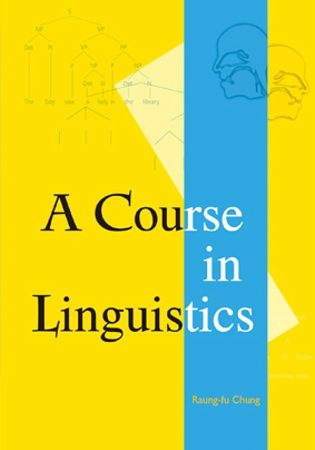- 定價217.00元
-
8
折優惠:HK$173.6

|
|
|
|
A Course in Linguistics(16K)
|

|

沒有庫存
訂購需時10-14天
|
|
|
|

|
|
9789863181460 | |
|

|
|
Raung-fu Chung(鍾榮富) | |
|

|
|
寂天 | |
|

|
|
2014年6月13日
| |
|

|
|
183.00 元
| |
|

|
|
HK$ 173.85
|
|
|
|
|

| |
|
|
|
|
| |
|
|
詳
細
資
料
|
ISBN:9789863181460叢書系列:Linguistics規格:平裝 / 256頁 / 19 x 26 cm / 普通級
Linguistics
|
|
分
類
|
語言學習 > 外語學習 > 各地外語 |
同
類
書
推
薦
|
|
|
內
容
簡
介
|
本書旨在引領初學者進入語言學的世界,以循序漸進的方式,從毫無語言學背景開始。目前,國內校園一般使用的語言學書籍都是在國外寫成的書,其不足之處,便是文中所舉的實例和語料來自世界其他各地,這對國內師生來說很陌生,因此較難達到良好的學習效果。
有鑑於此,本書特地以時下國內外通行的語言學理論為本,並且以國語、閩南語、客家語、原住民語(布農、泰雅)的語料與應用為實際分析案例,簡明扼要地探索語言知識(linguistic competence)和語用知識(pragmatic competence)的內涵,並分析兩者之間的互動。
對於英語學習者而言,掌握英語語言學固然是焦點,但如果也能把相關理論應用在台灣的語言上做分析與研究,那麼不但能達到理論與經驗交熔的理想,也能讓學習者瞭解將理論付諸應用的可行性。本書兼顧理論與語料分析,期望透過「做中學」的方式,能協助學習者解除心理的恐懼與障礙。希望本書能成為與語言相關科系(如英語教學、華語教學、溝通障礙、聽力治療)的墊基教科書。
本書行文明朗簡潔,舉證與語料貼切,組織層次分明,即使是初學者,也能自行從閱讀中學會語言學的基本概念。書中列有國際音標與K.K音標之比較,並附Glossary名詞解釋。全書共分為12個Chapter。
This accessible textbook provides beginners of linguistics with a step-by-step guide to the world of linguistics in general. Most of the data are based on English, Mandarin Chinese, Southern Min, Hakka, and Formosan languages. The essential motivation is to arm students with basic knowledge of languages in Taiwan when they are taught how to investigate properties of English linguistics. Designed for beginners, A Course in Linguistics equips learners with enough empirical data to illustrate each terminology together with the fundamental theories that underline it. This book was written with an attempt to combine theory and practice, achieving the goal of learning through doing linguistics. It was set to solve the difficulties or problems of which most Taiwanese students are afraid, and hence to become a leading text for the introductory courses.
•?? ?Accessibly written, and assumes little backgrounds for linguistics
•?? ?In a brief and precise style, specifically for EFL students
•?? ?Learning by doing, and hence providing a review for each topic
•?? ?Rich in concrete illustration based on data familiar to learners
•?? ?Well-organized in writing, equipping learners with critical reasoning
•?? ?Trying to teach or help instead of reshaping learners in thinking
|
|
目
錄
|
第1章?? 語言和語言學(Language and Linguistics)
第2章?? 語音學(Phonetics)
第3章?? 音韻學(Phonology)
第4章?? 構詞學(Morphology)
第5章?? 句法(Syntax)
第6章?? 語義學(Semantics)
第7章?? 語用學和篇章分析(Pragmatics and discourse analysis)
第8章?? 大腦和語言(Brain and Language)
第9章?? 語言習得(Language Acquisition)
第10章?? 第二語言習得(Second Language Acquisition)
第11章?? 社會語言學(Sociolinguistics)
第12章?? 歷史語言學(Historical linguistics)
Glossary
|
|
序
|
前言
The book was not intended to be a textbook at the beginning. I have to teach in English as I am working at the Department of Applied English at Southern Taiwan University of Science and Technology. It is true that I wrote in Chinese two different introductory textbooks for different purposes. Most of the data used there were novel and some were even based on unpublished research. They were, to some extent, of great value to me. In practical teaching, those data ran naturally into my lectures. In the process of editing the lectures into a book, I tried very hard to erase those published data. However, some were still left, though they appeared in English this time.
The readers are supposed to be English majors at the college level, who are not trained to be linguists in particular. For this reason, basic concepts about linguistics required for beginners are fully provided with a detailed illustration. The essential goal is to help teachers lead the students into a new field of humanity science: linguistics. Some of the terminologies and ideas might be foreign to students. However, more data together with further interpretation in this volume are expected to help them overcome difficulties in reading. Even if this is the case, I am still of the position that not every student was born or trained to be a linguist. When I was a college student, I was one of those who did not like linguistics. I was all at sea in the linguistic class. Nevertheless, what I was did nothing to stop what I am. For this reason, no student can be deprived of her/his right to be sitting comfortably in a linguistics class.
When I was asked to teach An Introduction to English Linguistics for those who wanted to be teachers, I spent a lot of time searching for a good textbook for this course. Although there were different versions of textbooks in the market, more than needed indeed, there were few suitable for our students as beginners. Most of the imported textbooks were both expensive and complicated in writing. Furthermore, most of the linguistic terminologies were illustrated with African or other un-known languages, which made teachers and learners feel even worse.
Under such circumstances, the idea occurred to me that I had to write a textbook in English. That’s the basic motivation for this volume. The goal of this book is essentially twofold. On the one hand, the price of the textbook should be less than half of most English textbooks in linguistics. On the other, most of the basic concepts should be interpreted on the basis of Mandarin, Southern Min, Hakka, or any Formosan language data. In other words, this is kind of nativized version of textbook on general linguistics.
Manuscripts of this book at different stage were used for teaching materials in the graduate and the undergraduate programs in the past three years. I would like to thank my students at Southern Taiwan University of Science and Technology for insightful feedbacks, most of which have been integrated here. In addition, many thanks are due to my assistants. Without their help, this work can never be possible. Finally, I sincerely thank the team of Cosmo Publishing Co. Ltd., who help this book come into being.
|
|
|
書
評
|
|
|
|
|

